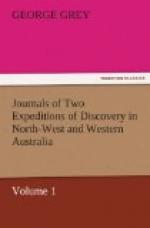I was unfortunately too unwell this day to describe all the other specimens we caught, which were numerous. The sea was full of small acalepha, and in the midst of a shoal of these a whale was seen.
November 19. Latitude 25 degrees 50 minutes south; longitude 106 degrees 22 minutes east.
Birds first re-appeared again. I saw a large flock of two kinds, but was not near enough to ascertain what they were. I have before noted the fact that almost at the exact point where the southern birds of the family Longipennes disappeared those sea-jellies (acalepha) which have the power of stinging, began to show themselves; previously to our passing this point I had not seen one: I saw several however today at no great distance from this flock of birds.
We saw float by this afternoon one of the acalepha, apparently about two feet long and shaped generally like a water snake; its tail had fins like that of an eel, of a purplish tinge; I could distinctly see its head and various vessels in its interior for it was quite transparent. We had no net ready but threw a stick with a piece of string attached to it, the string passed under it but in pulling up cut through it as though it had been jelly.
Caught an animal (Cymothoa) shaped exactly like a woodlouse:
Length 0.4 inches.
Length of antennae 0.15 inches.
Breadth of body 0.12 inches.
It had six legs, and a tail-like fin behind on each side, and nine rings on its back so that it could roll itself almost into a ball, these rings extended no farther than from its head to within 0.12 inches of its hinder extremity; colour very pale blue down the back, bright prussian blue on each side; it crawled about when taken out of the water, and lived for some time; its fins, or fin-like legs, when it thus crawled about, were folded under its tail; eyes distinct.
Mollusca.
November 20. Latitude 25 degrees 14 minutes south; longitude 106 degrees 49 minutes east.
A shell, Janthina exigua, was caught this evening, 8 hours 30 minutes P.M.; when brought directly out of the water into a room the temperature of the animal was 80 degrees 5’; of room 76 degrees; colour, dark violet purple over half the opening and lower part of the shell, so that it gives the animal the appearance of having been upon a purple-coloured place; this colour then dies gradually away, and in the smallest whorl of the shell becomes almost white. They had the power of emitting drops of a violet colour, and when put into spirits a great quantity of this issued from the mouth of the shells. We had one evening before caught a pair of shells of the same species, but much smaller, at exactly the same hour; in both instances each pair were caught at the same haul of the net.
November 23. Latitude 21 degrees 43 minutes south; longitude 109 degrees 43 east. 8 1/2 P.M.
Flying fish.
A flying-fish (Exocetus) flew on board. Its temperature
was 74 degrees.
The colour of its iris was black.




